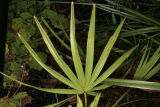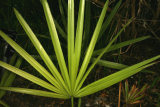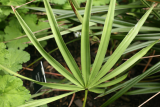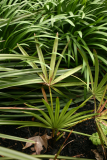Additional notes (click to expand)
Commemorative
Saw palmetto is named for Dr Sereno Watson (1820–92), a farmer’s son from Connecticut who graduated from Yale in 1847. He had no idea what to do with his life, so studied medicine at New York University, graduating in 1850, but only practising for two years (1854–6), with his elder brother Louis, in Quincy, Illinois. In 1866, he went back to Yale to study chemistry and mineralogy.
He remained unsettled and, in 1867, on the spur of the moment, decided to join a surveying expedition in California, so walked across the Sierra Nevada on his own. He helped the botanist in charge, Professor WW Bailey, to collect plants and here discovered his vocation. His work was so effective that, on Professor Bailey’s retirement due to illness, he became the botanist for the expedition (1868). When the expedition finished, he worked in the Gray herbarium at Harvard and published the Catalogue of the known plants of Nevada and Utah with 1,325 species (Watson,
1871) – a milestone in American botany. He was appointed Curator of the Gray Herbarium at Harvard in 1874, additionally looking after the botanic garden. He produced the Bibliographic index to North American botany (1878) and a hundred other publications, including co-authoring Botany. Geological survey of California (1876, 1880). He was a specialist on mosses, remembered as a shy, hard-working and infinitely diligent systematic botanist of the first rank (Coulter, 1892). He
died of viral myocarditis, aged 72, following influenza (Brewer, 1903).
Oakeley, Dr. Henry. (2012). Doctors in the Medicinal Garden. Plants named after physicians. Royal College of Physicians.
link
Horticulture
Serenoa repens is a slow-growing, clump-forming member of the Arecaceae family. It is native to the coastal areas of south-east USA. It has blue-green, fan-shaped leaves and produces creamy, fragrant flowers and olive-like fruits. It grows well in free-draining, moist soil in sun or semi-shade. Propagation is best from seed sown under glass, as plants are diffi cult to re-establish after division. It is one of the hardiest palms, surviving several severe winters outside at the
Medicinal Garden. (Clare Beacham)
Oakeley, Dr. Henry. (2012). Doctors in the Medicinal Garden. Plants named after physicians. Royal College of Physicians.
link
Medicinal
Traditional Herbal Medicine Registration (THMR).
Other use
Serenoa repens, Saw Palmetto, is widely used as a herbal medicine for benign prostatic enlargement, despite having no clinical effect whatsoever on bladder function or prostatic size.
Oakeley, Dr. Henry. (2012). Doctors in the Medicinal Garden. Plants named after physicians. Royal College of Physicians.
link
Indication: Relieve symptoms of urinary tract discomfort in men who have enlarged prostate.
Licensed for use in Traditional Herbal Medicines in the UK (UK Medicines and Healthcare Products Regulatory Agency (MHRA)).
Medicines and Health Care Regulatory Authority, 2013 Licensed Traditional Herbal Remedies
Toxicity
Side effects/precautions: Hypersensitivity; caution if taking medication for benign prostatic hypertrophy; may cause intra-operative haemorrhage, eructation and gastrointestinal discomfort, allergic reactions; may affect fertility. From Patient information leaflet for preparations licensed as Traditional Herbal remedies in the UK
Medicines and Health Care Regulatory Authority, 2013 Licensed Traditional Herbal Remedies
Geographical distribution
- Northern America, Southeastern U.S.A.
Serenoa repens (W. Bartram) Small
Family: ARECACEAEGenus: Serenoa
Species: repens (W. Bartram) Small
Common names: Saw Palmetto
Distribution summary: Northern America
Habit: Shrub
Hardiness: H3 - Half hardy; unheated greenhouse/mild winter
Habitat: lowland to mountain forests, forest margins, savannah woodland, open grassland, shady river banks
Garden status: Not currently grown
Flowering months: April, May
Reason for growing: Commemorative, medicinal, other use, toxic



